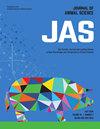与结构稳健性相关的5月龄后备母猪流动性措施的基因组分析
IF 2.7
2区 农林科学
Q1 AGRICULTURE, DAIRY & ANIMAL SCIENCE
引用次数: 0
摘要
母猪跛行导致过早扑杀,造成经济损失和健康问题。利用压力感应垫(GAIT4)和视频监控系统(NUtrack)进行了一项研究,以确定对后备母猪的客观测量,以预测未来的跛行。幼母猪(N = 3656)被分类为描述它们一生的健康状况:良好,保留用于繁殖,没有检测到移动问题;LAME_SOW,保留繁殖,检测跛子为母猪;CULL_STR,由于腿部结构不良而未保留;LAME_GILT,由于可见的跛行迹象而未保留;和CULL,由于腿部结构以外的原因没有保留。GAIT4系统为每只蹄创建一系列测量和跛行评分(GLS),而NUtrack每天记录动物的运动和姿势持续时间。为了确定GAIT4和NUtrack系统的测量是否与终生健康相关,在R中进行了混合模型分析,包括父系品种、当代组和终生健康评分的固定效应和动物的随机效应。第二个混合模型在没有终身健康评分的情况下运行,然后使用动物效应估计进行ssGBLUP分析,使用3代家系和基因型,来自&;gt;60%的表型动物。估计基因组遗传力,根据Bonferroni校正排列测试反向求解SNP效应和显著性。跛足的GAIT4特征(LAME_GILT和CULL_STR vs SOUND);P, lt;0.05)为GLS、平均步幅长度和平均站立时间的标准差,显著性NUtrack测量为进食、站立、侧卧、总卧、速度、距离和旋转。此外,旋转不同(P <;0.05),距离趋于不同(P <;0.10)。预测NUtrack性状的遗传力估计为~0.3,GAIT4性状的遗传力估计为~0.2。在47个基因组区域中有382个显著SNP效应,其中1、4、11和14号染色体上的4个区域占关联的60%以上。基因组水平的基因型将几个区域与可能的致病基因联系起来。GAIT4和NUtrack系统在5月龄时的客观测量结果是可遗传的,能够发现不健康的动物,并且与终生健康相关。本文章由计算机程序翻译,如有差异,请以英文原文为准。
Genomic analysis of mobility measures on 5-month-old gilts associated with structural soundness
Sow lameness results in premature culling, causing economic loss and well-being issues. A study, utilizing a pressure-sensing mat (GAIT4) and video monitoring system (NUtrack), was conducted to identify objective measurements on gilts that are predictive of future lameness. Gilts (N = 3656) were categorized to describe their lifetime soundness: SOUND, retained for breeding with no detected mobility issues; LAME_SOW, retained for breeding and detected lame as a sow; CULL_STR, not retained due to poor leg structure; LAME_GILT, not retained due to visible signs of lameness; and CULL, not retained due to reasons other than leg structure. The GAIT4 system creates a series of measurements for each hoof and a lameness score (GLS) while NUtrack records animal movement and posture durations each day. To determine if measurements from the GAIT4 and NUtrack systems were associated with lifetime soundness, mixed model analyses were conducted in R including fixed effects of breed of sire, contemporary group and lifetime soundness score and random effect of animal. A second mixed model was run without lifetime soundness score and estimates of animal effects were then used to conduct ssGBLUP analyses using 3 generations of pedigree and genotypes from ~50k SNP on > 60% of phenotyped animals. Genomic heritabilities were estimated, SNP effects were back-solved and significance based on Bonferroni corrected permutation tests. GAIT4 traits indicative of lameness (LAME_GILT and CULL_STR vs SOUND; P < 0.05) were the standard deviation of GLS, average stride length, and average stance time, while significant NUtrack measurements were eating, standing, lateral lying, total lying, speed, distance, and rotations. In addition, rotations differed (P < 0.05) between SOUND vs LAME_SOW and distance tended to be different (P < 0.10). Estimates of heritability for predictive NUtrack traits were ~0.3 and GAIT4 traits were ~0.2. There were 382 significant SNP effects in 47 genomic regions, four regions on chromosomes 1, 4, 11 and 14 accounted for over 60% of the associations. Genome-level imputed genotypes linked several regions with possible causative genes. Objective measurements from the GAIT4 and NUtrack systems at 5 months of age were heritable, able to detect unsound animals, and were associated with lifetime soundness.
求助全文
通过发布文献求助,成功后即可免费获取论文全文。
去求助
来源期刊

Journal of animal science
农林科学-奶制品与动物科学
CiteScore
4.80
自引率
12.10%
发文量
1589
审稿时长
3 months
期刊介绍:
The Journal of Animal Science (JAS) is the premier journal for animal science and serves as the leading source of new knowledge and perspective in this area. JAS publishes more than 500 fully reviewed research articles, invited reviews, technical notes, and letters to the editor each year.
Articles published in JAS encompass a broad range of research topics in animal production and fundamental aspects of genetics, nutrition, physiology, and preparation and utilization of animal products. Articles typically report research with beef cattle, companion animals, goats, horses, pigs, and sheep; however, studies involving other farm animals, aquatic and wildlife species, and laboratory animal species that address fundamental questions related to livestock and companion animal biology will be considered for publication.
 求助内容:
求助内容: 应助结果提醒方式:
应助结果提醒方式:


